Škoda Auto
Škoda Auto a.s. (pronunciation: Shkodda, ˈʃkɔda, ![]() ) is a Czech automobile and engine manufacturer, founded in 1895 as bicycle manufacturer Laurin & Klement by Václav Laurin and Václav Klement, producing the first automobile in 1905. In 2020, Škoda celebrated its 125th birthday, making it one of the oldest companies in the industry.
) is a Czech automobile and engine manufacturer, founded in 1895 as bicycle manufacturer Laurin & Klement by Václav Laurin and Václav Klement, producing the first automobile in 1905. In 2020, Škoda celebrated its 125th birthday, making it one of the oldest companies in the industry.
In 1925, the Škoda engineering group bought the company, which had been weakened by the First World War. As a result, vehicles were given the emblem Laurin & Klement - Škoda, and from 1925 onwards new models were only launched on the market as Škoda. The name was given to the industrialist and engineer Emil von Škoda. In 1930, the car manufacturer was given the name Akciová společnost pro automobilový průmysl (Joint Stock Company for the Automotive Industry) within the group, with the abbreviation ASAP. After the breakup of Czechoslovakia in 1939 by invading German troops during World War II, the car manufacturer became part of the German Reichswerke Hermann Göring. After the Second World War, the automobile plants were nationalized in 1945, and the automobile division ASAP was spun off from the conglomerate as Automobilové závody, národní podnik (Automobile Works, National Plant) with the abbreviation AZNP, and has since been operated under a planned economy. After the Velvet Revolution, in order to facilitate the privatisation of the car manufacturer, the state-owned enterprise was transformed into a joint-stock company called Automobilový koncern Škoda a.s. (Automobile Group Škoda Joint Stock Company) in 1990, so that the Czechoslovak government could sell Volkswagen AG a minority share in the company. In 1991, the company was renamed Škoda automobilová a.s. (Škoda Automobile Joint Stock Company). In 1997 the manufacturer was renamed to its current name Škoda Auto a.s.. Volkswagen AG gradually increased its shareholding in Škoda Auto, so that on 30 May 2000 Škoda Auto was wholly owned by Volkswagen.
Today, there is also Škoda Transportation a.s. which manufactures locomotives, buses and trams, among other things, and which, like Škoda Auto, emerged from the Škoda Group.
In 2020, the automaker sold 1,004,800 vehicles, exceeding one million per year for the seventh consecutive year. On April 11, 2019, Škoda celebrated the production of 22 million vehicles in the entire history of the company.

Škoda parent plant in Mladá Boleslav

Board members Christian Strube, Klaus-Dieter Schürmann, Alain Favey, Bernhard Maier, Michael Oeljeklaus and Dieter Seemann at the presentation of the Škoda Vision X at the 2018 Geneva Motor Show.
History
1895 to 1905 - Foundation of Laurin & Klement
→ Main article: Laurin & Klement
The company was founded in Mladá Boleslav on 18 December 1895 by a bookseller Václav Klement and a bicycle mechanic Václav Laurin. Laurin was a partner of the company Kraus & Laurin in Turnov, which repaired bicycles. The initiative to establish the factory came from Klement. He had been annoyed with the Dresden manufacturer Seidel & Naumann, as they did not want to take into account his complaint in Czech about the poor durability of his bicycle.
Initially, bicycles of the Slavia brand were built and repaired, followed three years later by models with auxiliary motors. In 1898, a small factory was built outside Mladá Boleslav, employing 40 workers. In 1899 the first motorcycles were produced and from 1905 automobiles. By the end of 1902, the two thousandth motorcycle had already left the factory. The L&K motorcycles were very successful in competitions, in 34 races in 1903 they won 32 victories. In 1905 L&K built 19 different motorcycles with one and two cylinder engines as well as the four cylinder CCCC 5HP. As early as 1901, L&K had been involved in the development of automobiles and exhibited a vehicle with a two-cylinder engine at the Automobile Exhibition in Vienna.
1905 to 1914 - Start of automobile production
In 1905, the first automobiles were built, first the Voiturette with a 1005 cm³, water-cooled, 7 hp two-cylinder and a short time later the Type B with 9 hp and 1399 cm³. In 1907 the types B2 with 2278 cm³ and 10 hp and the type C, a taxi with 12 hp followed.
In 1907 the company was converted into a joint-stock company, in 1912 the Reichenberger Automobil Fabrik was taken over and soon the company was the largest automobile manufacturer in Austria-Hungary. In 1909, the designer Otto Hieronimus, who had previously worked for Benz and Daimler, was hired. He was also a racing driver and developed the FCR type, a racing car that reached 130 km/h. In addition to motorcycles and automobiles, Laurin & Klement also built stationary engines, commercial vehicles, buses, agricultural machinery and road rollers. Around 40% of the automobiles were exported to Russia, and vehicles were also exported to Japan, South America, New Zealand and most European countries. In the years up to 1914, Laurin & Klement vehicles were very successful in racing events.
1914 to 1925 - The sale of Laurin & Klement to Škoda
After the start of the First World War, production was switched to armaments and it was not until 1919 that automobile production could be resumed. It was not easy to regain the civilian market. The L&K car factory found itself in the young Czechoslovak Republic. Before 1914, L&K had sold only 30% of its cars on the territory of what was now Czechoslovakia, 20% in the rest of the monarchy and 50% had been exported. However, with the end of the First World War and the reorganization of Europe, market conditions changed. There was still demand, but the high cost of materials meant that production was not very profitable. The automobile had once again become a luxury product, and it was expensive to run.
The first to appear after the war were the Type Sh and the small car Type T. These were followed by larger models with six-cylinder petrol engines and Knight slide control. In the period from 1905 to 1925, around 60 different car models were built.
L&K tried to shorten the way to the customer by opening a repair and sales workshop in the Lesser Town of Prague in 1920.
Gradually, Klement realized that the future belonged exclusively to series production and that only mass production could create a cheap or affordable Volkswagen. That is why L&K decided to enter into a partnership with the Škoda plants in Pilsen.
On 27 June 1925, the merger with the Pilsen Škoda Works took place, with Laurin remaining technical director. The automobile models built at this time were continued to be built by Škoda Auto, as the new company was called, first under the name "Laurin & Klement - Škoda" and then under the name "Škoda". The construction of bicycles and motorcycles was completely discontinued.
1925 to 1945 - First Republic, German occupation and nationalization
In 1930, the car division of the large corporation was spun off under the name Automobilindustrie-Aktiengesellschaft Škoda (ASAP Škoda). After the world economic crisis of the 1930s, Škoda achieved a new breakthrough with the Popular. During the Second World War, Škoda belonged to the German state corporation Reichswerke Hermann Göring. Under pressure from the German occupying forces, Škoda now mainly produced various types of bucket and off-road vehicles with four-wheel drive, as well as the heavy wheeled tractors Ost, and assembled individual weapon parts. In addition, gears, shafts and radiators were produced for BMW and Daimler-Benz. On 9 May 1945, the factory building in Mladá Boleslav was attacked by unknown bombers. The body workshops, the physics and chemistry laboratory and the design office with all the old, archived plans were destroyed. The Red Army took over the organization in the main plant in MladáBoleslav on May 10, 1945. On June 7, 1945, the first works council was established. On October 24, 1945, the company was nationalized and gradually integrated into the beginning planned economy. After 1945, the plant was spun off from the Škoda Pilsen Group, retaining the company name, and continued as a national enterprise.
1945 to 1990 - setbacks and successes
In 1947, truck manufacturing was spun off and continued first by Avia, then from 1951 by LIAZ under the Škoda brand. In the early/mid-1950s, new compact and mid-range passenger car models were released, including the convertible Felicia. In 1956, the decision was made to develop a rear-engined, rear-wheel drive passenger car. However, development work was delayed, and series production did not start until 1964 with the construction of the rear-engined 1000 MB model. A new plant had been built for this purpose in Mladá Boleslav, which at the time was one of the most modern in Europe. In August 1969, large parts of the plant were destroyed by fire. From the 1960s onwards, the range of vehicles was limited to the mid-range. Further rear-engined passenger car models followed, 100/110 and the Type 742 (105, 120, 125, 130, 135), of which there were also sporty coupés as the 110 R, Garde and Rapid. In the GDR, Škoda models were among the most important imported cars and accounted for around 10% of the total passenger car stock. In 1962, the 20,000th Škoda passenger car was imported into the GDR.
In 1969-1972 Škoda tried to offer an innovative vehicle with the concept of a generously proportioned saloon (Type 720) with front engine, automatic transmission and ABS; however, it remained with a few prototypes such as station wagons, hatchbacks and notchbacks with the design of Giorgio Giugiaro. For the socialist leadership of Czechoslovakia, the vehicle appeared too "western"; moreover, a large part of the still new production machinery would have had to be replaced. This proved to be uneconomical. Czechoslovak citizens were indirectly told that the Soviet Union had prevented series production. It was not until 1987 that Škoda returned to the front engine with the Škoda Favorit designed by Giuseppe Bertone.
1990 until today - Sale to Volkswagen
As part of the privatisation process that began in 1990, the Czechoslovak government decided on 9 December 1990 to sell the then AZNP (Automobilové závody, národní podnik) to Volkswagen AG. On 16 April 1991, Škoda became the fourth brand in the Volkswagen Group. Other interested parties included the car manufacturers Renault and BMW, but their concepts for the future appeared less convincing than Volkswagen's. In 1991 the German importer Škoda Auto Deutschland GmbH was founded in Weiterstadt, from 1995 a wholly owned subsidiary of Škoda Auto, a.s. The joint venture with Volkswagen resulted in the Škoda Felicia with a modern design. In 1993, Dirk van Braeckel became the new chief designer and designed the first generations of the Škoda Fabia and Škoda Octavia models. With these models, Škoda regained a significant market share in Western Europe. In 1998, Škoda automobilová a.s. became the joint-stock company ŠKODA AUTO a.s. and for the first time produced 400,000 passenger cars, which were exported to 70 countries. After the Volkswagen Group gradually increased its share in Škoda Auto, it has owned 100% of the company since May 30, 2000.
Due to Škoda's connection with cycling, Škoda has supported cycling, including the Tour de France since 2004, replacing FIAT. In 2008, the new GreenLine model variant, a fuel-saving version, and the ESP safety program were introduced as standard. In the Russian and Ukrainian markets, Škoda achieved good economic figures in 2009. In the same year, the most vehicles in the company's history to date were delivered, with a total of 684,226 vehicles. In China, Škoda was able to increase its sales figures by 107% to 122,556 vehicles in 2009. In Germany, 190,717 cars were delivered, an increase of 57.3%. One of the reasons for this strong increase in sales was the government scrapping premium in Germany and other European countries.
The brand's sales success led to a dispute with VW headquarters over future model policy in spring 2010.
In 2011, Škoda presented its new corporate design at the Geneva Motor Show. At the same time as the Škoda Vision D design study, the manufacturer also presented a new brand logo to the public. The goal for 2011/12 is an affordable "world car". This should be placed in the price segment of under 8000 euros. The manufacturer also expressed interest in a larger SUV in the form of the VW Touareg and in acquiring a stake in the Volkswagen Commercial Vehicles division. At the end of September 2011, the company unveiled the Škoda Citigo, a long previously announced subcompact car on which the Volkswagen up! is also based. Shortly afterwards, production of the Škoda Rapid began in Pune (India). Production of the European Rapid began in 2012. At the same time, Škoda developed the new Seat Toledo for its Spanish sister company Seat, which is largely identical in construction to the Rapid. Production runs on assembly lines at Škoda's main plant in MladáBoleslav. With 939,202 vehicles delivered in 2012, the brand surpassed the previous record set in 2009.
In 2012, Škoda introduced the "GreenFuture" environmental strategy as part of its 2018 growth strategy. It is designed to further improve the company's sustainability. GreenFuture is based on three pillars. GreenProduct is aimed at new models with further reduced fuel consumption and exhaust emissions, while GreenFactory is designed to make production at Škoda's own production facilities 25% more environmentally friendly, for example by significantly reducing energy and water consumption as well as waste and carbon dioxide emissions. GreenRetail describes improved environmental protection in the dealerships and workshops, which is to be monitored by regular audits.
In February 2013, the fifteen millionth Škoda rolled off the production line. Production of the third generation of the Octavia and the Rapid Spaceback, the brand's first short-tail model in the lower mid-size segment, started. Škoda presented it at the IAA together with the facelift of the Yeti.
Škoda's strongest sales market in fiscal year 2013 was China, with 226,971 deliveries to customers, followed by Germany (136,415) and Russia (87,456). In China, local production of the Octavia III began in spring 2014. In Russia, production of the Škoda Rapid has been taking place since spring 2014. Today, Škoda is represented in over 100 countries.
Since 2006, Škoda Auto, like many other car manufacturers, has again been offering bicycles for sale. These come from Asian production. The bicycles are sold through the car brand's authorised dealers. The Škoda brand started with bicycles made by Laurin & Klement before motorcycles and later cars were produced. The Škoda Muzeum Mladá Boleslav houses several models from the early years of production. From about 1900 onwards, bicycle production stagnated almost completely, with only individual models of mopeds being produced. It was not until the 1970s that Škoda bicycles returned to the public.
In 2016, Škoda adopted its "Strategy 2025" in parallel with other brands in the Volkswagen Group. In this strategy, the company defines electromobility, digitalization and internationalization as key areas of action. In addition, the company aims to generate a similarly high level of sales with digital services in the long term as it does with its traditional automotive business.
At Auto Shanghai in April 2017, the manufacturer unveiled the Škoda Vision E, the first design and technology study to feature an all-electric powertrain. According to the company, the prototype is a preview of the manufacturer's electric mobility. The corresponding SUV series model is scheduled for market launch in 2020.
At the 2019 International Motor Show, the company announced the creation of the Škoda iV sub-brand for models with electrified powertrains. At the same time, Škoda announced the plug-in hybrid SUPERB iV and the battery-electric subcompact CITIGOe iV.
On behalf of the Volkswagen Group, Škoda Auto has been in charge of the Group's planned model initiative in India since mid-2018. The Group plans to invest a billion euros there between 2019 and 2021. In order to guarantee maximum market proximity, the models for the Indian market are to be tailored to the needs of drivers there and developed and produced almost entirely in India. To this end, Škoda Auto and Volkswagen opened a new technology centre in Pune, India, in early 2019, where 250 engineers will work. A software development center with offices in Gurugram and Pune has been supporting the automaker's IT worldwide and developing digital services since February 2020.
In order to drive forward the digitalisation of products and corporate processes as well as the development of digital mobility services, the car manufacturer founded the Škoda Auto DigiLab in Prague at the beginning of 2017. In the following years, offshoots opened in Tel Aviv, Israel (2018), in the Chinese capital Beijing (2019) and in Pune in the Indian state of Maharashtra (2020). The DigiLabs see themselves as part of the local start-up scenes and are to look for suitable cooperation partners and ideas there in order to develop digital mobility services and new business models. At the same time, local IT talent is being promoted and developed.
In the summer of 2020, Thomas Schäfer became the new Chairman of the Board of Management; he was previously Managing Director of Volkswagen South Africa.
Worldwide sales
| Model | 1997 | 1998 | 1999 | 2000 | 2001 | 2002 | 2003 | 2004 | 2005 | 2006 | 2007 | 2008 | 2009 | 2010 | 2011 | 2012 | 2013 | 2014 | 2015 | 2016 | 2017 | 2018 | 2019 | 2020 | |
| Škoda Citigo | - — | - — | - — | - — | - — | - — | - — | - — | - — | - — | - — | - — | - — | - — | 510 | 29.960 | 45.225 | 42.494 | 40.152 | 40.674 | 37.115 | 39.200 | 31.200 | 15.000 | |
| Škoda Felicia | 288.458 | 261.127 | 241.256 | 148.028 | 44.963 | - — | - — | - — | - — | - — | - — | - — | - — | - — | - — | - — | - — | - — | - — | - — | - — | - — | - — | - — | |
| Škoda Fabia | - — | - — | 823 | 128.872 | 250.978 | 264.641 | 260.988 | 247.600 | 236.698 | 243.982 | 232.890 | 246.561 | 264.173 | 229.045 | 266.763 | 240.470 | 201.989 | 160.518 | 192.358 | 202.303 | 206.499 | 190.900 | 172.800 | 105.500 | |
| Škoda Kodiaq | - — | - — | - — | - — | - — | - — | - — | - — | - — | - — | - — | - — | - — | - — | - — | - — | - — | - — | - — | 447 | 99.961 | 149.200 | 171.800 | 131.600 | |
| Škoda Rapid | - — | - — | - — | - — | - — | - — | - — | - — | - — | - — | - — | - — | - — | - — | 1.671 | 24.692 | 103.781 | 221.363 | 194.321 | 212.656 | 211.480 | 191.500 | 142.100 | 79.700 | |
| Škoda Octavia | 47.876 | 102.373 | 143.251 | 158.503 | 164.134 | 164.017 | 165.635 | 181.683 | 233.322 | 270.274 | 309.951 | 344.857 | 317.335 | 349.746 | 387.183 | 409.632 | 359.578 | 389.257 | 432.335 | 435.974 | 418.767 | 388.200 | 363.700 | 257.400 | |
| Škoda Superb | - — | - — | - — | - — | 177 | 16.867 | 23.135 | 22.392 | 22.091 | 20.989 | 20.530 | 25.645 | 44.548 | 98.873 | 116.726 | 109.087 | 94.433 | 91.084 | 80.176 | 138.854 | 150.910 | 138.100 | 104.800 | 86.200 | |
| Škoda Roomster | - — | - — | - — | - — | - — | - — | - — | - — | - — | 14.422 | 66.661 | 57.467 | 47.152 | 32.332 | 36.010 | 37.964 | 33.295 | 29.643 | 16.612 | 29 | 1 | - — | - — | - — | |
| Škoda Yeti | - — | - — | - — | - — | - — | - — | - — | - — | - — | - — | - — | - — | 11.018 | 52.604 | 70.321 | 87.397 | 82.449 | 102.867 | 99.547 | 95.540 | 69.467 | 13.100 | - — | - — | |
| Škoda Kamiq | - — | - – | - – | - – | - – | - – | - – | - – | - – | - – | - – | - – | - – | - – | - – | - – | - – | - – | - – | - – | - – | 27.900 | 64.600 | 128.500 | |
| Škoda Karoq | - — | - – | - – | - – | - – | - – | - – | - – | - – | - – | - – | - – | - – | - – | - – | - – | - – | - – | - – | - – | - – | 115.700 | 152.700 | 137.200 | |
| Škoda Enyaq iV | - — | - – | - – | - – | - – | - – | - – | - – | - – | - – | - – | - – | - – | - – | - – | - – | - – | - – | - – | - – | - – | - – | - – | 600 | |
| Total | 336.334 | 365.500 | 385.330 | 435.403 | 460.252 | 445.525 | 449.758 | 451.675 | 492.111 | 549.667 | 630.032 | 674.530 | 684.226 | 762.600 | 879.184 | 939.202 | 920.750 | 1.037.226 | 1.055.501 | 1.126.477 | 1.200.535 | 1.253.700 | 1.242.800 | 1.004.800 | |
| Source |
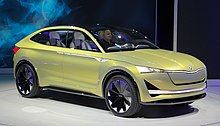
Škoda Vision E concept car with electric drive presented in 2017

Škoda Superb II (2008-2013)
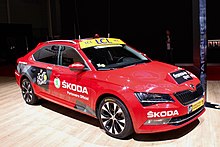
Škoda Superb III as a support vehicle for the Tour de France, on display at the 2018 Paris Motor Show.

Škoda at the autumn fair in Leipzig, 1980
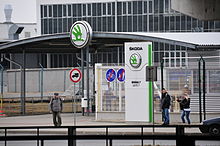
Entrance 7 to the current plant in Mladá Boleslav
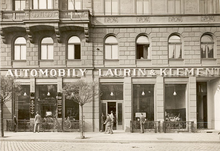
Prague Motor Show, 1925
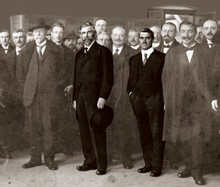
1895: Foundation of the company Laurin & Klement
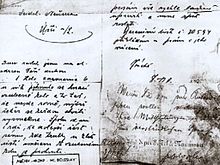
Letter of complaint to the bicycle manufacturer Seidel & Neumann
Škoda Motorsport
→ Main article: Škoda Motorsport
With its traditional motorsport division, the manufacturer participates directly in the World Rally Championship (WRC). With the Škoda Fabia R5, Škoda Motorsport won the World Rally Championship-2 manufacturers' world championship in the team classification in 2015, 2016, 2017 and 2018.
.jpg)
Škoda Fabia R5, FIA World Rally Championship-2
Questions and Answers
Q: What is Škoda Auto?
A: Škoda Auto is an automobile maker based in the Czech Republic.
Q: When was Škoda bought by the Volkswagen Group?
A: Škoda was bought by the Volkswagen Group in 2000.
Q: How many cars did Škoda sell in 2009?
A: Škoda sold 684,226 cars in 2009.
Q: In what year did Škoda sell 85,000 cars in the month of March?
A: Škoda sold 85,000 cars in the month of March 2011.
Q: Where is Škoda Auto based?
A: Škoda Auto is based in the Czech Republic.
Q: Who is the owner of Škoda Auto?
A: The Volkswagen Group is the owner of Škoda Auto.
Q: What is the pronunciation of Škoda?
A: The Czech pronunciation of Škoda is [ˈʃkoda] (listen).
Search within the encyclopedia